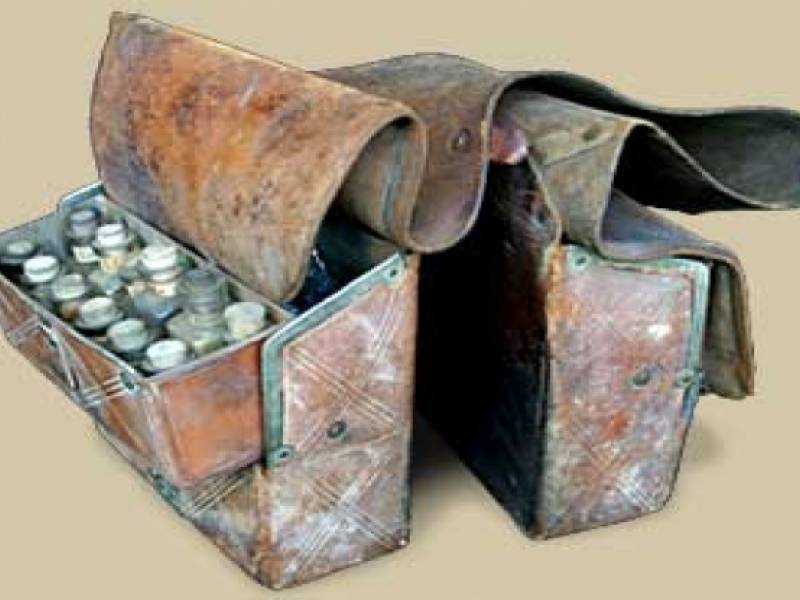- About Us
- Museum
- Preservation
- Research
- Contact Us
Medicine Before Penicillin
You are here
Life Before Series...
For some time now we’ve been contemplating writing a series of focused articles on very specific subjects – the kind of things school children rarely read about in their history text books.
The writings will be made available in paper form as well. Called “The Before… Series.” We are concentrating on the decade of the 1920’s – a time of great change, social upheaval, easy credit, hard roads, electricity, radios, golf.
Yet it was also a time when most McHenry County residents still live on family farms, attended one-room schools and remembered the so-called “Good Old Days.”

"Feed a fever, starve a cold" – or is it the other way around?
My grandmother had many sayings like that!
Remember onion plasters, mustard plasters, oh how they burned our chests! But they would cure a chest cold, wouldn’t they?
Vicks Vaporub was rubbed on the chest and around the nose to clear up the nasal catarrh! And is still being used.
Many old cookbooks (1800 – 1925) had remedies for the "sick and invalids" that are not understandable to us.
"Avoid having a kerosene lamp in the bedroom – odor is irritating to the mucous membranes."
"Keep all medicines or anything suggestive of illness out of sight in a sickroom: (Good idea).
"Never visit a sickroom in a violent perspiration or with an empty stomach."
"Diet should be food which satisfies the ‘humour,’ but does not nourish or stimulate." That is gruel, gelatinous soups, or aromatic drinks" (ugh).
"Teething children should have milk from one cow – this cow should NOT be fed on green corn or sour apples!"
"For summer complaints, use scaled milk, (not boiled) also rice jelly or barley gruel!"
Enough of that! Let’s get a little closer to our times! Here are some "sure cures."
For poison ivy – use juice of a milkweed plant.
Insect repellent – rub snake root between hands, put on face.
For a sty on eyelid, lay a flax seed in corner of your eye.
Car sickness – two tablespoons of sauerkraut juice will settle the stomach.
Liniment prescription:
1 part vinegar
1 part alcohol
1 part turpentine
Let alcohol eat up one cake camphor before adding to other ingredients. (1946)
A dirty wool sock around your neck for a sore throat – the dirtier the better!
Patent medicines were very popular in the late 1800’s and still are in many places!
Remember Doan’s Little Liver Pills, Lydia Pinkhams Tonic for Women, Beecham’s Pills – just a few of the many. Some were well-laced with alcohol or opium.
Fortunes were made in America by quackery – mostly for treatment of sexual problems. Men were told that their "days" were few, unless they took extensive courses of various treatments.
Almost as prevalent were treatments for alcoholism. In Illinois was the Keeley Institute, run by Dr. Leslie Keeley, a qualified physician. It is difficult to decide whether Dr. Keeley was a quack or not! His treatment was injections of gold bichloride. Alcoholics from all over the country came to Dwight, Illinois for the Keeley treatment. The "cure" often succeeded, probably, due as much to decreasing amounts of alcohol each day, as to the gold bichloride. Keeley Institutes were in 40 cities in the U.S.
There is a Keeley Institute still, under different management, using orthodox methods of treatment – and no gold bichloride.
The First World War stimulated research and interchange of ideas. That most important analgesic, aspirin was a brand name of the German company, Bayer, and acquired by the Allies under the Enemy Property Act. Lysol was another invention of this company.
Before World War II tetanus antitoxin was available, as well as sulfamycin, both of which saved many lives. "Sulfa" powder was put in open war wounds, helping them heal without infection.
Actually hand washing, clean operating rooms and changing clothes between surgical patients began in the mid 19th century, but was not popular until much later. Now we are getting even more stringent about washing hands almost between every activity – even teaching primary students to sing "Happy Birthday to You" three times while washing hands after bathroom visits!
Do you remember when families and houses were quarantined for "communicable diseases" i.e., mumps, scarlet fever, whooping cough and measles? Either the whole family was unable to leave the house for some weeks, or usually the husband couldn’t come in the house or some of the "well" children had to be farmed out! After the patient was "cured" the house was fumigated with sulfur candles.
Aren’t you glad that there are antibiotics, immunizations, important technology and well-educated physicians to keep us "well" now? By 2100 we will be looking back and laughing at the strange medical practices in the 19th and 20th centuries.
by Dr. Alice Mijanovich
- Research Library
- • Reference & Archival Materials >
- Sears Home Map of Crystal Lake
- Heritage farms
- Historic Links
- How to Research Your Property
- • Forgotten McHenry County >
- • Life Before Series >
- • Statistics >
We Want You!
Volunteers are needed for various other projects! If you are interested in local history or have other skills you can contribute, please complete our Fillable Volunteer Form. If you have any questions, please phone our office at 815-923-2267.
Sign up for the free MCHS Monthly Newsletter.
 © 2025 MCHS- All Rights Reserved.
© 2025 MCHS- All Rights Reserved.


